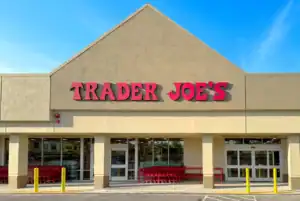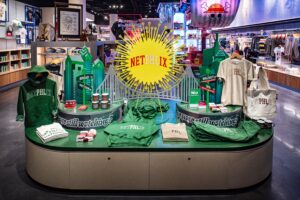
Illustration: Getty Images/Olga Kurbatova
March 6, 2023
RFID was made for BOPIS
Through a special arrangement, presented here for discussion is an excerpt of a current article from the blog of Nikki Baird, VP of retail innovation at Aptos. The article first appeared on Forbes.com.
The challenge with RFID is adoption. I’ve hosted too many round tables and panel discussions where there is one retailer at the table who has adopted item-level RFID in stores and everyone else has not.
The adopter is an evangelist facing a room full of skeptics.
Based on discussions at the recent NRF Big Show, RFID is not at the tipping point but is certainly still on an upward adoption trend.
Any tech person worth their salt will shudder when they see the term “real-time.” Real-time data is expensive both from a solution architecture and a network perspective. Before omnichannel processes like buy online pickup in store (BOPIS), a daily snapshot of inventory at the end of the selling day was real-time enough.
No longer.
If the website can’t see what’s sold in the store since it opened this morning, retailers must put buffers on the available inventory for things like BOPIS. Retailers don’t want to cancel orders, but taking an item off the website simply because you can’t be sure you have enough in stores to continue offering it for ship-from-store – that is costly too.
With item-level RFID, you don’t have to look in every store every second – again, that would be very expensive to support – but if a customer views an item’s online product detail page, you could certainly take a glance in the stores, most likely to be used for fulfillment to see if enough of the item is on hand to fulfill if the customer adds it to the cart.
From what I’ve seen, retailers need to put 100 percent item coverage in one store, with 100 percent reader coverage in the same store, to understand what’s possible and how it could change their lives.
Most retailers looking for real-time inventory seek better intra-day visibility into inventory snapshots. A few retailers are ready to see whether RFID can get them that and maybe something more.
Discussion Questions
DISCUSSION QUESTIONS: Is the business case for item-level RFID becoming more evident from a need and cost perspective? What barriers remain that are holding back fuller deployment?
Poll
BrainTrust
Recent Discussions







Where do I start? (We wrote a detailed whitepaper on this recently!) The price of RFID tags has dropped dramatically over the last decade, yet retailers still say it’s too expensive. The benefits far outweigh the costs. The savings in labor for those retailers who use security tags, who have to take markdowns, who need to find individual items on the floor, and the speed gains at checkout are just amazing. Not to mention the security advantages at self-checkout. Each of these use cases is addressed with RFID. Real-time retail is table stakes against Amazon who is real-time all the time.
Any retailer who is skeptical about RFID and real-time should try to measure ALL the costs of not adopting it. Lost sales and confusing demand caused by stockouts, safety stock and workaround logistics to adjust for blind spots in stock levels, and disgruntled customers who hate substitutions in online orders. Everything adds up, while the price per RFID tag goes down.
RFID can deliver so much more than just benefits to a BOPIS operation, however it is likely that it will be restricted to high-value items and top-end retailers for a while yet. The problem is and always has been one of the cost: cost of tags, cost of applying them and the cost of reading them. All these costs have decreased significantly over recent years and the read rates have improved massively making it a much more attractive proposition, but it is still too expensive to be mass-market technology just yet.
To be a viable business case the opportunity must outweigh the costs and in this case, the opportunity of “near real time” must outweigh the costs of less costly, batch processes like “end of day” or “twice a day.” It sounds like even with the projected growth of BOPIS over the next few years, retailers are content waiting for the data to support making such a significant investment because the benefits of “near real time” (or real time) do not yet sufficiently outweigh the benefits of alternative methods.
There is no doubt that retailers can’t promise to have the product for a BOPIS order without the certainty that the unit is, indeed, available for sale and that, once the order is accepted, it can’t be sold again. Item-level RFID is the only technology available that enables retailers to know that. Retailers appear to resist spending — not on the tags anymore, but on the reading devices. When retailers are done disappointing enough customers, they will adopt item-level RFID.
I’m sure there is a Moore’s Law equivalent for RFID and real-time data tracking. With increasingly pervasive connectivity, cheap compute cycles, and AI/Big Data, it should be a given in today’s retail industry.
Although RFID costs have come down, they are still significant in relation to low priced SKUs such as a single banana. BOPIS is a growing channel for grocery, but not every SKU makes sense. Until that gap gets closed further and can be applied store-wide the full adoption may be slow.
I feel like we’ve been discussing the merits of RFID on RetailWire for as long as I’ve been a panelist (more than 15 years) and probably longer. Retailers who are still avoiding the technology and its benefits are simply making a cost-based decision. Even before BOPIS and ship-from-store became omnichannel best practices, the argument for improved inventory management via RFID has always been compelling.
With all of the supply chain disruption since the beginning of COVID-19 this should be obvious. If retailers had identified the rush for specific items the first day it happened, they could have limited the sale to one per customer immediately instead of three weeks later when they had no inventory. With the weather issues, it has been necessary to shift inventory to other locations. Being able to identify that need quickly would be important. How expensive was the supply chain shutdown to your company? If you knew where all your inventory was and how much was being sold where, how much money would you have saved? Isn’t it worth the investment in being able to identify where every piece of inventory is at any point in time before another disruption happens?
As Dick Seesel rightly points out RFID’s growth curve has a long arc, possibly longer than some RetailWire readers have been alive, and that might be part of the problem. Generations of retailers have heard first the buzz, then the hype around RFID and failed to see the promised benefits. I personally remember when it was hailed as the savior of warehousing, at least until it turned out that it had a hard time dealing with humidity and drastic temperature variations. Then the problem was the readers. And so on, and so on. The technology has obviously improved. The cost/benefit ratios are in much better alignment. And the real hangup seems to be 30-plus years of unfulfilled capability assertions. My suggestion? Rebrand it. Change the name. Call it anything but RFID and maybe its day will have finally come.
I have been saying RFID will be the next old tech to become new again for a while. The cost is the primary barrier for retailers, and I also think another key barrier is the lack of understanding as to all the value it would provide. Everything in retail has ultimately come down to the importance of data, and RFID is such a rich source of that. The possibilities are endless if it is actually adopted and embraced.
From a store operations perspective, the benefits of implementing RFID far outweigh the costs. The speed of using RFID to read the tags in the store creates the opportunity to count the entire store daily (versus manual counts which occur once a year.) An associate using an RFID handheld can count up to 30,000 products per hour! With an RFID Scanner, associate can walk the store with the trigger enabled, reading product tags from up to a 15 ft. radius.
If an item is purchased from Store A but returned to Store B, the item will get added to Store B’s RFID inventory record, either through the Return transaction, or through the next RFID Count. There is a comprehensive SOP, that retailer have to implement to be successful with RFID. There are some smaller accessory items like drinkware containers, shoe care products, wallets, belts, sunglasses, safety accessories, jewelry etc., that sometimes have RFID tagging issues, and make RFID difficult to implement. RFID can help retailers with so much more than just benefits to the BOPIS operation.
Widespread RFID adoption is still being held back based on cost. This has been the case for many years, going all the way back to the RFID gold rush that never happened, regarding Walmart potentially mandating RFID. Further, in order to take full advantage of item level “real time” inventory information based on RFID, other areas need to be ready to fully take advantage of this information — for example, is the rest of the supply chain within the retail set to react quickly to item level movement at store level? This is not a point solution waiting for roll out, in other words — it is dependent on the agility of the retailer as a whole.
I often get frustrated when we talk about RFID because it is a powerful and much-needed solution but only for certain merchandise categories. An absolute “yes” for consumer electronics and department-store dresses. An absolute “no” for frozen pizza and heads of lettuce.
To me, all that discussion about the cost of the tags (which once mattered) is now just so much smoke. It’s not the budget that is lacking — the ROI is easy to grasp — it’s the knowhow and the will.
We are at the tipping point for adoption of In-Store Sensing in the broader sense. This defines an array of technologies for tracking merchandise and people that include video analytics, LiDAR, mobile device-tracking, smart displays, and of course those pesky radio-frequency tags. Retailers require the complete and continuous view into store conditions and shopper behaviors that these sensing technologies can provide.
With a nod to Ryan Matthews’ wise comment about the need to re-brand this solution, how about we change the terminology to Item-Level Sensing, or ILS?